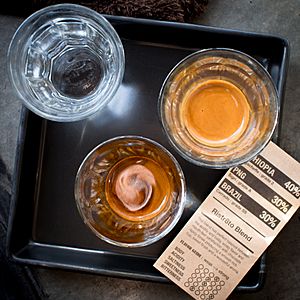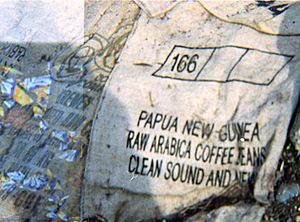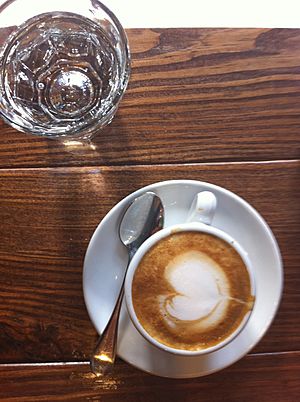Coffee production in Papua New Guinea facts for kids
Coffee production in Papua New Guinea is super important for the country! It's the second biggest farm export, right after oil palm. About 2.5 million people work with coffee, which is a huge number. Papua New Guinea (often called PNG) produces about 1% of the world's coffee.
Coffee brings in the most foreign money for PNG. Most of it grows in the Eastern Highland, Western Highland, and Simbu provinces. Unlike many places where coffee was grown on huge farms by colonial powers, in PNG, most coffee comes from small farmers. These farmers might only have about 20 coffee trees in their "coffee gardens" alongside other food crops. Because these farms are often in isolated areas, much of the coffee is certified as "organic."
Contents
History of Coffee in PNG
Coffee growing in PNG started a long time ago, around 1926–1927. That's when the first Jamaican Blue Mountain Coffee seeds were planted. Some say coffee was brought to British Papua even earlier, in 1890, but it really became a business in the late 1920s. In a place called Sangara, Papua New Guinea, 18 coffee farms were set up in 1926, and they started selling coffee in 1928.
In the 1960s, PNG built more roads and other important things. This helped the coffee industry grow a lot because it was easier to move coffee beans from farms to places where they were processed and sent overseas. The coffee business did really well in the 1970s. This was partly because Brazil, another big coffee producer, had problems with frosts, which meant less coffee from them on the world market.
In the 1980s, big coffee farms in PNG started to produce less. Instead, small local farmers began to grow most of the coffee. Today, these small farmers produce over 85% of all the coffee in PNG! However, some coffee farms faced big debts during this time. Also, from 1986, a plant disease called coffee rust (caused by Hemileia vastatrix) started to affect some coffee plants in PNG.
The coffee industry in PNG was at its best in 1998. Back then, it made up about 38% of PNG's exports that weren't minerals. But since then, the industry has faced challenges. World coffee prices dropped a lot, sometimes by 60%. This caused coffee production to fall by 23% in 2000.
Today, one big problem is that roads and other important structures are not always good. Also, sometimes coffee is stolen, which is a major issue in PNG. Some big coffee growers lose as much as half of their coffee each year because of theft. This means less money for the farmers and the country. It's often linked to young people not having enough chances for education or jobs.
More countries are growing coffee now, which also affects PNG's coffee business. In 2009, coffee made up 18.5% of PNG's farm exports. In recent years, people in the coffee business and the government have been working together more. They are trying to make coffee growing more sustainable, helping farmers learn better ways to take care of their land and soil.
How Coffee is Produced
About 87,000 hectares (or 215,000 acres) of land in Papua New Guinea are used to grow coffee. Most of this coffee is grown in the highlands, where 70% of the people rely on farming to live.
Around 2.5 million people work in the coffee industry in PNG. This includes about 280,000 small-scale coffee growers, 660 larger farmers, 65 big plantations, 18 registered companies that export coffee, 51 companies that process coffee, and over 6,000 roadside buyers.
Even though 12 provinces grow coffee, most of it (about 90%) comes from five highland provinces: Western Highlands (45%), Eastern Highlands (37%), Simbu (6%), Morobe (5%), and East Sepik (5%).
In the late 1990s, PNG produced about 1.18 million bags of coffee every year, and all of it was sent to other countries. Most of the coffee grown in PNG (95%) is a high-quality type called washed mild arabica. The other 5% is lowland washed robusta. Robusta coffee is usually darker, more bitter, and has less flavor. It's often used for cheaper instant coffee.
The better quality arabica coffee is often used to make espresso, cappuccino, and latte in places like Switzerland, Germany, France, and Italy. It's also used by American coffee companies like Starbucks. Most of the coffee sold to North America comes from big farms in the West and East Highlands, like Sigri and Arona coffee. The very best PNG coffee that's widely sold comes from the Colbran estate in the Eastern Highlands.
Types of PNG Coffee
"PNG" is the name given to a popular type of coffee from the eastern part of the island. There are two main kinds:
- One kind is made by large farms using a "wet process." This coffee is mostly sold in the USA.
- The other kind is grown by small farmers in their backyards, also using the wet process.
The coffee from large farms includes famous brands like Sigri and Arona. These are "high-grown" coffees, meaning they grow at high altitudes. They are known for their nice smell and rich taste, similar to coffees from Maritime Southeast Asia. Coffee grown by small farmers is often organic. One well-known type from small farmers is "Village Premium Morobe," which comes from the Morobe Province.
Challenges for Coffee Growers
One of the biggest problems for coffee farmers in Papua New Guinea is the poor quality of basic things like rural roads. This often means coffee can't be sold and stays on the farms. This leads to farmers losing money or having to sell their coffee for very little just to get by.
Other challenges include:
- Farmers sometimes switch from coffee to other crops that make more money or are better for food.
- Families have limited land, which stops them from growing more coffee.
- There aren't always enough workers during the main coffee picking season.
- Young people often move from villages to cities to find better jobs.
- The price of coffee on the world market can go down. If prices stay low for a long time, the government might need to help small farmers with money so they can keep going until prices get better.
Threats to the Industry
The coffee industry in PNG faces several threats:
- Many coffee trees are old (27–47 years old) and need to be replaced, but this isn't always happening on time.
- There are large debts in the industry.
- Pests and diseases like Coffee Berry Disease (CBD), Berry Borer, and Pink Disease can harm coffee plants. It's important to stop these diseases from spreading.
Keeping Coffee Quality High
The coffee grown in PNG is naturally very high quality, often good enough for special coffee shops. However, sometimes the quality is not as good as it could be because of poor management and processing. Local people might not have the best tools or knowledge to process large amounts of coffee, deal with diseases, or give the delicate arabica coffee the care it needs.
The Coffee Product

PNG coffee is grown naturally because artificial fertilizers and pesticides are too expensive and hard to get. This means the coffee naturally has low levels of caffeine and acidity. Papua New Guinean coffee is often described as having a medium body, low to medium acidity, a smooth feel in your mouth, and often fruity flavors.
The Coffee Industry Corporation Ltd. is an important group that helps the coffee farming community. They set rules, help things run smoothly, and provide research and support to farmers. They give farmers reasons to keep producing coffee, focusing on good quality and helping them sell their coffee.
Help for Farmers
Several programs have been started to help farmers. For example:
- Farmers can get plants from special nurseries at a lower cost.
- There's a 'Coffee Credit Scheme' that has helped over 11,000 farming communities.
- A 'Freight Subsidy Scheme' helps pay for 40% of air transport costs.
- They've also set up standards for coffee beans and created a special standard called 'Premium Smallholder Coffee' (PSC). This is for the Gourmet coffee market, which wants very high-quality coffee.
Specialty coffee from Papua New Guinea has become popular with buyers from Japan after a special event. The great thing about this coffee is that it's grown in its natural environment without any artificial fertilizers, pesticides, or weed killers.
Coffee Research
The coffee industry in PNG gets support from research done by the Coffee Research Institute (CRI). This institute was started in 1986 in Aiyura in the Eastern Highlands Province. It's part of the PNG Coffee Industry Corporation. In 2003, CRI and another division joined to form the Research & Growers Services Division.
The main goal of this research and support is to make sure that small farmers, blocks, and plantations can keep producing coffee. They want to meet international standards for both quality and cost-effectiveness. The corporation actively helps farmers by setting up nurseries, giving out licenses, providing land, getting money from international groups like ACIAR and the European Union (EU), and offering some financial help.
Improving Coffee Quality
The quality of coffee from PNG has been improving a lot recently. There's a focus on setting up "wet factories" and making sure the coffee is tested in well-equipped labs to ensure excellence. Also, a special tasting panel has been trained in Lae and Australia. This will help PNG coffee get more attention in the international market.



